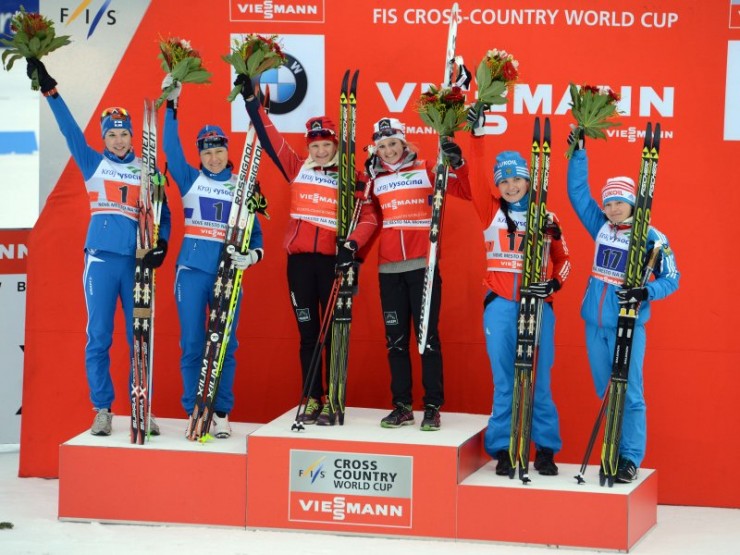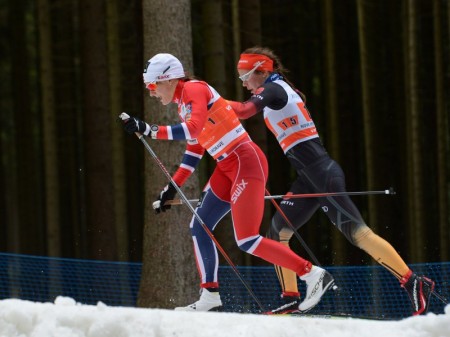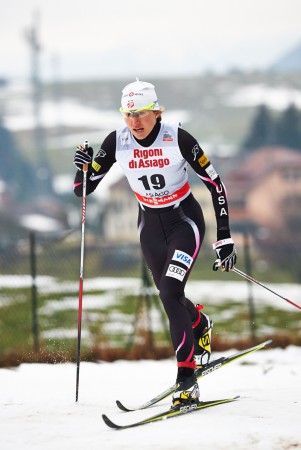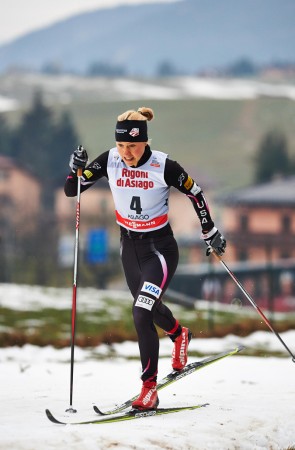
Note: This report has been updated to include quotes from Ida Sargent of the U.S. Ski Team.
If history is a guide, Sunday’s classic team sprint in Nove Mesto, Czech Republic, was destined to end as showdown between Finland and Norway.
Finland, led by Mona-Lisa Malvalehto and Aino-Kaisa Saarinen, was favored to win the relatively rare event on the World Cup. This was just the 12 time a team classic sprint has been held on either the World Cup or World Championships, and in the eleven previous occasions, Finland landed on the podium nine times. Finland came into the race on a hot streak, having won three of the last five classic team sprints, including three weeks ago in Asiago, Italy.
The Norwegians, for their part, had won the event both previous times the World Cup brought it to the Czech Republic, although they started the day having won only once in the last five. Norway I’s team of Maiken Caspersen Falla and Ingvild Flugstad Østberg must have felt it was an auspicious day, though, as they won the freestyle team sprint together a year ago in Liberec, Czech Republic.
The United States, having won two of the last three feestyle team sprints, has never reached the podium in a classic team sprint. The U.S. Ski Team was also without Kikkan Randall and Sadie Bjornsen. U.S. Head Coach Chris Grover explained, “We did not have Kikkan with us; she had a minor strain to one of her muscles in her back a couple weeks ago so she’s still taking it kind of easy on the back. She was being a little bit cautious today and we didn’t really have Sadie to use either; she’s been fighting off a little bit of a cold this past week.”
The U.S. had one team in the event, with Ida Sargent leading and Sophie Caldwell anchoring.
The course was a thick ribbon of artificial snow that curled around the green, snowless forests of Nove Mesto. With no snow in Central Europe, Grover praised the event coordinators, saying, “The organizer did a fantastic job of getting the races off despite some really warm temperatures, and absolutely no snow anywhere nearby. Hats off to the Nove Mesto organizer, they really did an awesome job.”

Leading the team sprint out of the gate was Norway II’s Kathrine Rolsted Harsem. Behind her was Norway I’s Falla and Finland’s Malvalehto.
Behind the Finn was Russia I’s Anastasia Dotsenko, and Russia II’s Evgenia Shapovalova. Britta Norgren Johansson skiing for Sweden II lost her balance on an icy corner on the first lap and fell, breaking her pole as she did so, and putting her well off the back of the pack and fighting to give her teammate Hanna Erikson a chance to catch up.
The U.S. was led by Sargent who tagged off to Caldwell in seventh at the first exchange.
“My strategy was to just stay relaxed, controlled, and in the mix for the first couple laps and try to go for it as much as I could on the last lap,” Sargent wrote in an email.
The second lap was led out of the stadium by Celine Brun-Lie of Norway II, chased by Østberg of Norway I, and Finland’s Saarinen.
Russia I’s Natalia Matveeva and Russia II’s Julia Ivanova were right behind as was Swtzerland’s Laurien Van der Graaf, who held a small gap ahead of Caldwell, skiing in sixth.

Caldwell described the strategy for the early laps in an email. “I think the general idea is just to try to hold on for as long as possible,” she wrote. “You definitely want to be able to conserve a little energy for the last lap if possible, but you also want to try to maintain contact with the leaders.”
On the top of the climb on the second lap, Østberg took the lead on the long gradual climb into the stadium from Brun-Lie.
At the second exchange Østberg handed off in first, with Finland, Norway II, and Caldwell in fourth.
Malvalehto took off on the third lap, leading up the early climb and created a small gap to Norway I and II who in turn held a small gap on Sargent who was being chased by Russia I and II.
On the climb back to the stadium, Falla took back the lead from Malvalehto to hand off to Østberg in first for Norway I. The Russian teams had caught Sargent to put the U.S. in sixth at the third exchange.
“It was a really fast paced and hard race but fun,” Sargent wrote.
Despite the variable course profile and the number of laps, the race stayed quite consistent, without much movement in positions with the exceptions of the crashes.
“It wasn’t as hard to make moves as it was during the skate sprint,” Caldwell wrote, “But I think it’s hard to make moves in team sprints in general because people are usually going close to as hard as possible the whole time. The course was pretty flat, but I think it skied much flatter as a skate course. I v2’ed basically the whole course yesterday, but today I was striding as much or more than double poling.”
The fourth lap was dominated by Saarinen and Østberg who created a sizeable gap on the rest of the field. Coming into the stadium for the fourth exchange, Matveeva caught her ski and fell, putting Russia I behind in a critical stage of the race.
While the tracks were generally in good condition, the course itself varied throughout the 1.3 k loop. “It was definitely variable out there,” Grover said. “There were icy parts, there were a little bit softer parts, and there were places that were pretty hard to get kick.”

Of the course, Caldwell said, “It got below freezing last night so the course actually hardened up a lot over the night. The pole tracks were starting to break down, but the tracks held up quite well.”
Falla and Malvalehto skied together out of the stadium on their final lap with a five second gap to Russia II’s Shapovalova. On the final climb, Shapovalova made a huge effort and closed down the gap between her and Falla and Malvalehto. The three came into the stadium together for the final exchange.
Saarinen led out of the stadium and through the course with Østberg and Ivanova hanging on. Saarinen appeared to be in control of the race until the long gradual climb into the stadium. Østberg jumped into a track from behind Saarinen and began striding powerfully, taking the lead from Saarinen and then dropping her altogether as she entered the stadium with a comfortable gap to sprint to victory.
The Norwegians won in 20:58.47 minutes, 3.8 seconds ahead of Finland in second. Ivanova was right on Saarinen’s heels, placing third another 0.76 seconds back. Caldwell anchored the U.S. to sixth (+34.18), behind Russia I’s Anastasia Dotsenko and Natalia Matveeva in fourth (+26.01) and Norway II’s Kathrine Rolsted Harsem and Celine Brun-Lie in fifth (+26.70).
“I thought Ida and Sophie did a great job getting themselves through the finals and fighting for every second in the finals and ended up sixth, so that was really cool,” Grover said.
Falla told FIS, “I am of course very happy about the result today. I felt much better than in Asiago. Ingvild had a great day and skied amazingly.”
Despite Finland being favored to win today, Malvalehto told FIS, “I am happy with today’s result. My shape has been good. Of course we always aim for the victory but to win in such a tough competition requires that everybody has her best day. But I am happy for the second place.”
The Russians, surely hoping for a medal in this event in Sochi, were also content with the day’s result, considering that Russia I crashed out of contention. “It feels great to be on the podium today,” said Shapovalova. “We had a great day. I was pushing hard to stay in touch with the leading group. I felt sorry for Natalia (Matveeva) when she fell. But such things happen in the sprints. It was a great day for Russia.”
The U.S. Ski Team will stay in Nove Mesto until Thursday when they travel to Szklarska Poreba, Poland, for next weekend’s World Cup. Poland, like the rest of Central Europe, is utterly devoid of snow, and the organizers have declared that there will be no official training at the Polish venue until Friday as they try to ready the course. The team will have to train on the loop of man-made snow in Nove Mesto.
Grover explained that “there’s really no other option than that for hundreds and hundreds of kilometers. So that’s what those guys will do. The only other option for us would be to drive all the way back to the Alps and then all the way to back to Szklarska Poreba and that’s not really a smart decision.”
Grover views the lack of snow as a temporary concern. “Our camp for the Olympics is in Seiser Alm [Italy], is at high altitude and they have lots of snow, and Toblach [Italy], has good snow, where we’re going prior to the games, and Sochi has good snow, so there’s not really any worries besides this week.”
The World Cup continues on January 18th with a freestyle sprint in Szklarska Poreba.
Pasha Kahn
Pasha Kahn writes and coaches in Duluth, Minnesota.



